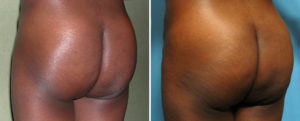Buttock Augmentation by Autologous Fat Injections
I have previously discussed buttock enlargement through the use of implants, known as implant or alloplastic gluteoplasty. Another popular option is buttock enlargement through the use of fat injections or transplants, known as autogenous gluteoplasty. Fat injections as a method for soft tissue volume enhancement is well known and has a good track history in the face where smaller amounts of fat are needed, usually in the range of 1 to 10ccs. In the buttocks, however, much larger amounts of fat are needed to make a significant size difference, usually in the range of hundreds of ccs per buttock.
Here in my practice in Indianapolis, I always discuss the merits of buttock implants vs fat injections for buttock enlargement. Fat injections to the buttocks have several advantages. First, it eliminates the need for a synthetic implant and all the inherest risks such as infection, implant malpositioning, and notoriously a seroma build-up or fluid collection. Second, the buttock enlargement operation is much simpler, less invasive and has less pain after surgery. Thirdly, the amount of recovery is dramatically different with no activity limitations after surgery unlike implants. Fourth, there is an added cosmetic bonus from the harvest at the donor site. Some other body area gets to be reduced at the same time, usually the abdomen, waistline, or thigh areas. A two-for-one bonus if you will.

The most important question for patients who want to avoid a buttock implant by undergoing fat injections for buttock enlargement then is; is the price and recovery from possibly two surgeries better than having a buttock implant? That is a question that each patient has to decide on their own in consultation with their plastic surgeon.
Dr Barry Eppley
Indianapolis, Indiana


